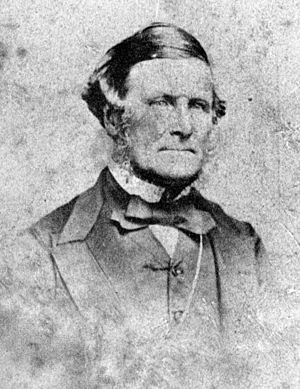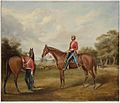Joseph Fowles facts for kids
Joseph Fowles (born 1809, died 1878) was a talented artist and teacher in Australia. He is most famous for his book, "Sydney in 1848". This book showed detailed pictures of Sydney's streets and buildings from that time.
Contents
Early Life and Arrival in Australia
His Journey to Sydney
Joseph Fowles was an artist. We don't know much about his early life. But we do know about his journey to New South Wales. He kept a journal during his trip. This journal is now kept at the Mitchell Library in Sydney.
While on the ship, he painted on the deck. His journal has pictures of islands and ports he saw. He arrived in Sydney on August 31, 1838. He came as a passenger on a ship called the "Fortune". He first stopped in Hobart.
Life in Sydney
Joseph Fowles' journal says he rented a farm. It was called Figtree Farm. This farm was in Hunters Hill. It was owned by Mary Reibey. On the farm, he grew fruits and vegetables. He also sold timber in Sydney.
The Fowles family lived in Hunters Hill for many years. His first wife, Sarah, returned to England. Joseph then lived with his companion, Emily Lambrigg Collyer. They had seven children together.
Joseph Fowles as an Artist
Marine Painter
In the 1840s, Fowles opened an art studio. It was in Harrington Street in Sydney's Rocks area. He became known for painting pictures of the sea. These are called marine paintings.
In 1847, there was the first public art show in the colony. It was put on by the Society for the Promotion of Fine Arts in Australia. Joseph Fowles showed seven of his paintings there. Five of them were of ships. One painting was of "Kangaroos". This was his first known animal painting.
The Sydney Morning Herald newspaper called him a marine painter. They said he was good at capturing how ships really looked. He showed three more sea paintings in another exhibition in 1849.
Pictures of Sydney
"Sydney in 1848"
Joseph Fowles' most important art project was "Sydney in 1848". This was a series of detailed pictures. They showed the town of Sydney in 1848. Sydney had changed a lot since Fowles arrived. He wanted to show the busy new city. His pictures showed important buildings. These included offices, shops, churches, and homes.
"Sydney in 1848" came out in 20 parts. It was published every two weeks between 1848 and 1850. These pictures were very popular. The full collection was published again in 1878, 1882, 1962, and 1973.
Fowles thought people in Britain didn't know how big Sydney was. He wanted to change this idea. He wrote about his goal in the book: "The main goal of this Work is to correct wrong ideas. People in England have bad ideas about this City. We will show Sydney as it truly is. We will show its wide streets lit by gas. We will show its busy people. We will show its public buildings and fancy shops. They are as good as those in London itself."
His work is still an important source today. It helps us understand Sydney's early history.
Sydney Views
After "Sydney in 1848", Fowles started painting landscapes. He focused on views of Sydney. These included scenes around Millers Point. He also painted Sydney homes like Bungarrabee (Eastern Creek) and Emu Hall (Penrith).
His street scenes included a picture of Stephen Butts. He was a publican. The painting showed him on a white horse. He was outside his stylish house in Macquarie Street. This painting showed Fowles' other artistic skill. He was also good at painting animals, especially horses.
Painting Horses and Animals
Joseph Fowles loved painting horses. This was because he loved horse racing. He painted pictures for people who asked for them. He also showed his work in art shows in the 1850s and 1860s. He started a successful business. He sold portraits of famous racehorses.
He built stables near Randwick racecourse. They were called The Newmarket training stables. The Sydney Morning Herald newspaper reported on these stables. They said they were built by 'Mr Fowles, the well-known animal painter of Sydney'. They called them 'the most complete place of its kind in the colony'.
He had some money problems with the stables. But he stayed connected to the racing world. He was part of the Homebush Jockey Club. He was also part of the Tattersall’s Club.
Joseph Fowles as a Teacher
The success of "Sydney in 1848" helped Fowles start a new career. He became a drawing teacher. He taught for the rest of his life.
His first teaching job was at a private school in Liverpool Street, Sydney. This was from 1851 to 1852. After that, he taught at many public schools. He had a long and important career in education. He taught at the Sydney Mechanics' School of Arts (1854–1861). He also taught at Sydney Grammar School (1867–74). And he taught at Kings School (1871–73).
He became the drawing master for the Board of National Education. This board later became the New South Wales Department of Education. Fowles wrote books to teach drawing. One was called the "Sydney Drawing Book". This book was used in NSW government schools until the 1880s.
It is said that because of Fowles, drawing was taught in every government school in New South Wales by 1869. This was a very early time for that to happen.
Later Life
Joseph Fowles had seizures later in his life. His obituary says that a third seizure was fatal. He died on the evening of June 25, 1878.
The Sydney Morning Herald remembered him for his art. They called him the "father of drawing in the city." They mentioned "Sydney in 1848". They also said he was great at painting animals. His work in education was also praised. He was drawing master for the National Board of Education for many years.
Gallery
See also
- Australian art








